Australia Fats & Oil Market Overview
Australia Fats & Oil Market Size was valued at USD 1,979.36 million in 2022. The Australia Fats & Oil market industry is projected to grow from 2022 to USD 2,857.85 million by 2032, exhibiting a compound annual growth rate (CAGR) of 3.78% during the forecast period (2022 - 2032). The fats and oils market in Australia represents a vital segment within the country's food industry, encompassing various products derived from both plant and animal sources. Fats and oils serve as essential components in food processing, culinary applications, and industrial uses, playing pivotal roles in flavor enhancement, texture modification, and nutritional supplementation. Defined broadly, fats are lipids that are solid at room temperature, while oils are liquid at the same condition. In the Australian market, these products are sourced from diverse origins, including vegetable oils such as canola, soybean, sunflower, and olive, as well as animal fats like tallow and lard.
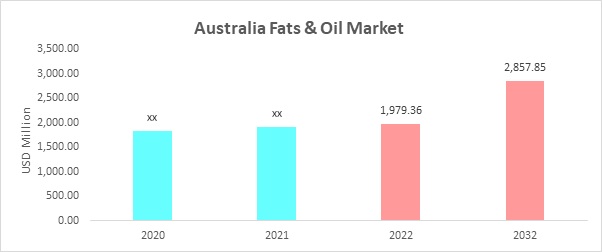
Source: Secondary Research, Primary Research, MRFR Database and Analyst Review
Australian fats and oils Market Trends
Consumer preferences are evolving towards healthier and sustainable solutions which is reflected in the significant trend of plant-based oils becoming more and more popular in the Australian fats and oils industry. Demand for oils that comes from plants which come from sources including avocado as well as soybean and sunflower has surged because of these oils' purported health advantages and compatibility with plant-based diets. The increasing popularity of these oils is attributed to consumers who are health conscious and are looking for options with less saturated fat and to those who are embracing oils that come from plants diets. In response to this trend produces capitalization on consumer demand for natural and less processed solutions by launching a range of plant-based oil products and mixes. The growth of plant-based oils reflects a larger social movement towards healthier, more sustainable eating habits which is reshaping the Australian fats and oils industry.
Australian fats and oils Type Insights
The Australian fats and oils market segmentation, based on the type, the market has been segmented into oil and fats. Among them, oil segment is the largest segment of the market accounting for 73.32% of the Australian market in 2022. The oil segment within the fats and oils industry in Australia represents a diverse array of products derived from various plant and animal sources. These oils serve as essential components in both culinary and industrial applications, catering to the needs of consumers and businesses alike. One prominent type of oil in this segment is vegetable oil, which encompasses oils extracted from seeds, fruits, and nuts such as canola, sunflower, soybean, and olive oil. Canola oil holds a significant market share due to its versatility, mild flavor, and high smoke point, making it suitable for frying, baking, and salad dressings. Sunflower oil, with its light taste and high levels of vitamin E, finds applications in cooking and skincare products. Soybean oil is another key player, known for its neutral flavor profile and high smoke point, making it a preferred choice for frying and industrial food processing.
Figure 1: The Australian fats and oils Market, by product type, 2022 & 2032 (USD Million)
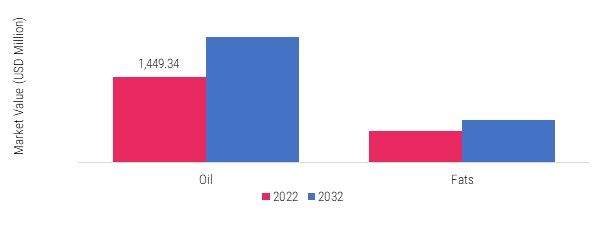
Source: Secondary Research, Primary Research, MRFR Database and Analyst Review
The Australian fats and oils End User Insights
The Australian fats and oils market segmentation, based on end user, Australia fats & oil market has segmented into residential and commercial. The commercial segment held the largest market share (78.87%) in 2022. The residential segment of the fats and oils market in Australia encompasses consumers who purchase and utilize fats and oils for household cooking, baking, and food preparation purposes. This segment represents a vast portion of the market, catering to individual households and their culinary needs. In Australian homes, fats and oils are fundamental ingredients used in various cuisines, including frying, roasting, baking, and salad dressings. The commercial segment of the fats and oils market in Australia caters to businesses and institutions such as restaurants, cafes, bakeries, catering services, and food manufacturers. Unlike the residential segment, which focuses on individual consumer preferences and needs, the commercial sector operates on a larger scale to meet the demands of food service establishments and industrial food production.
Figure 2: The Australian fats and oils Market, by end user, 2022 & 2032 (USD Million)
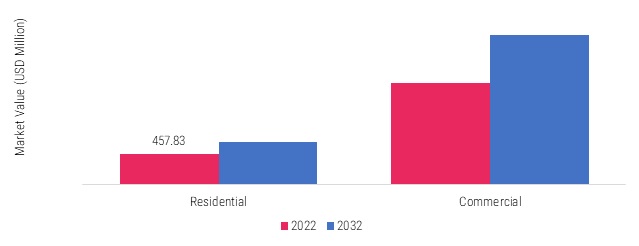
Source: Secondary Research, Primary Research, MRFR Database and Analyst Review
Australian fats and oils Source Insights
The Australian fats and oils market segmentation, based on the source, the market has been segmented into plant (canola, olive, cottonseed, and others), animal (pig, cattle, sheep and others). Among them, plant segment is the largest segment of the market accounting for 89.98% of the Australian market in 2022. Plant fats and oils in Australia are primarily derived from various sources, including canola, olive, cottonseed, and others. Canola oil, extracted from the seeds of the canola plant, is one of the most widely consumed vegetable oils in Australia. It is known for its high smoke point and neutral flavor, making it suitable for a wide range of culinary applications, including frying, baking, and salad dressings. Canola oil is also praised for its heart-healthy properties, being low in saturated fat and high in monounsaturated and polyunsaturated fats.
Figure 3: Australian fats and oils Market, by Sector, 2022 & 2032 (USD Million)
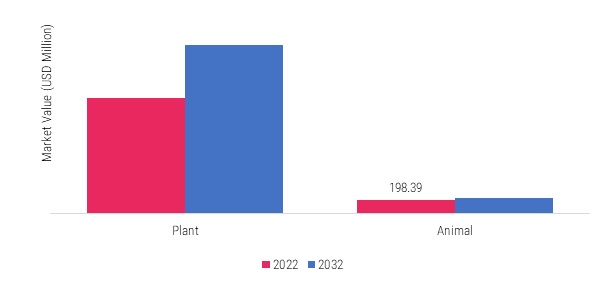
Source: Secondary Research, Primary Research, MRFR Database and Analyst Review
Australian fats and oils Sales Channel Insights
The Australian fats and oils market segmentation, based on sales channel, Australia fats & oil market has segmented into direct and indirect. Among them, indirect segment held the largest market share (77.08%) in 2022. In the direct sales channel, manufacturers can build strong brand loyalty and trust with consumers by directly addressing their needs and concerns. They can tailor their marketing strategies and product offerings to specific consumer segments, resulting in a more personalized shopping experience. Additionally, direct sales channels often provide manufacturers with valuable insights into consumer preferences and market trends, enabling them to adapt quickly to changing demands.
Figure 4: Australian fats and oils Market, by Sales Channel, 2022 & 2032 (USD Million)
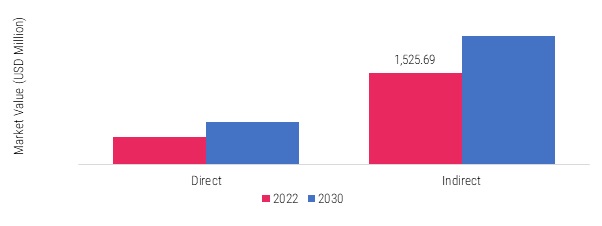
Source: Secondary Research, Primary Research, MRFR Database and Analyst Review
Australian fats and oils Application Insights
The Australian fats and oils market segmentation, based on the application, the market has been segmented into food & beverages, bakery (chocolate & confectionery, culinary, dairy & frozen desserts, and others), cosmetics & personal care, animal feed, pharmaceuticals, and others. Among them, food & beverages segment is the largest segment of the market accounting for 61.74% of the Australian market in 2022. The Food & Beverages segment within the fats and oils industry in Australia encompasses a diverse range of products and applications. Fats and oils are integral ingredients in many food and beverage formulations, serving various purposes such as flavor enhancement, texture improvement, and shelf-life extension. In food processing, fats and oils are used in the production of snacks, fried foods, sauces, dressings, and margarine, among others. They play a crucial role in providing mouthfeel and contributing to the sensory attributes of food products. Additionally, fats and oils are essential components in the formulation of various beverages, including flavored drinks, smoothies, and nutritional supplements. The versatility of fats and oils makes them indispensable in the food and beverage industry, where they are utilized for their functional properties and nutritional benefits.
Figure 5: Australian fats and oils Market, by Application, 2022 & 2032 (USD Million)
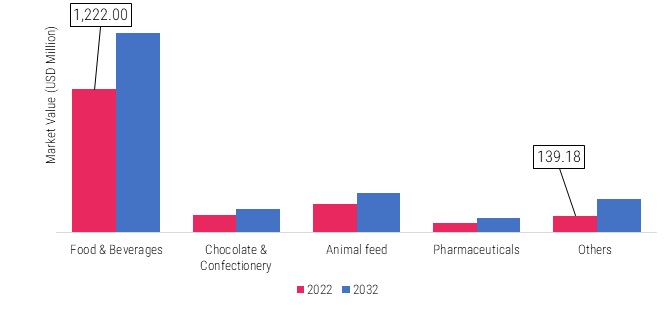
Source: Secondary Research, Primary Research, MRFR Database and Analyst Review
Australian fats and oils Key Market Players & Competitive Insights
The fats and oils market in Australia is characterized by both domestic players and multinational corporations vying for market share. At the forefront of the industry are established companies such as Goodman Fielder, a leading integrated food company renowned for its diverse portfolio of fats and oils products. Goodman Fielder boasts a strong presence in the Australian market, leveraging its extensive distribution network and brand recognition to maintain a competitive edge. In addition to domestic giants, multinational corporations like Cargill and Wilmar International also play significant roles in shaping the competitive landscape of Australia's fats and oils market. Cargill, a global leader in the agribusiness sector, maintains a formidable presence in Australia through its expansive portfolio of oils and fats offerings. Leveraging its expertise in supply chain management and agricultural processing, Cargill remains a preferred partner for Australian food manufacturers seeking high-quality fats and oils solutions. Moreover, the fats and oils market in Australia is characterized by the presence of niche players and emerging startups catering to evolving consumer demands for healthier and sustainable alternatives. Companies such as Cobram Estate, a premium olive oil producer, exemplify the growing trend towards artisanal and locally sourced fats and oils products. Cobram Estate's commitment to quality and sustainability resonates with health-conscious consumers seeking premium and ethically sourced oils. Furthermore, startups like Melrose Health are disrupting the market with innovative products such as coconut oil and MCT oils, targeting health-conscious consumers seeking functional ingredients for dietary supplementation.
Key Companies in the Australian fats and oils market include
- Cargill, Inc (US)
- Bunge Limited (US)
- Wilmar International LTD (Singapore)
- Archer Daniels Midland Company (US)
- Mewah International Inc (Singapore)
- Fuji Oil Holdings Inc. (Italy)
- Nestlé (Switzerland)
- Conagra Foodservice, Inc. (Japan)
- Premium Vegetable Oils Sdn Bhd (Malaysia)
- 3F Industries Limited (India)
- Unilever Plc (UK)
- Associated British Foods Plc (UK)
Australian fats and oils Industry Developments
November 2021: Cargill has started construction on a USD 35 million expansion of its production facility in Port Klang, Malaysia to meet growing customer demand for specialty fats. This is the first step in a multi-year, global investment expected to exceed US$100 million aimed to significantly expand the company’s global portfolio in specialty fats.
July 2021: ADM expanded its product portfolio in vegetable oil to meet ‘green diesel’ demand.
Australian fats and oils Market Segmentation
Australian fats and oils by Product Type Outlook
Australian fats and oils End-user Outlook
Australian fats and oils Source Outlook
Australian fats and oils Sales Channel Outlook
Australian fats and oils Application Outlook
- Food & Beverages
- Chocolate & Confectionery
- Animal feed
- Pharmaceuticals
- Others
| Report Attribute/Metric |
Details |
| Market Size 2022 |
USD 1,979.36 million |
| Market Size 2032 |
USD 2,857.85 million |
| Compound Annual Growth Rate (CAGR) |
3.78% (2022-2032) |
| Base Year |
2022 |
| Forecast Period |
2022-2032 |
| Historical Data |
2019-2021 |
| Forecast Units |
Value (USD Million) |
| Report Coverage |
Revenue Forecast, Competitive Landscape, Growth Factors, and Trends |
| Segments Covered |
By Product Type, End-User, By Source, By Sales Channel, and by Application |
| Geographies Covered |
Australia |
| Countries Covered |
Australia |
| Key Companies Profiled |
Cargill, Inc (US), Bunge Limited (US), Wilmar International LTD (Singapore), Archer Daniels Midland Company (US), Mewah International Inc (Singapore), Fuji Oil Holdings Inc. (Italy), Nestlé (Switzerland), Conagra Foodservice, Inc. (Japan), Premium Vegetable Oils Sdn Bhd (Malaysia), 3F Industries Limited (India), Unilever Plc (UK), Associated British Foods Plc (UK) |
| Key Market Opportunities |
· Shift towards premium oils for culinary and cosmetic purposes. · Demand for specialized oils: grapeseed, macadamia, and sesame. |
| Key Market Drivers |
· Growing consumer demand for healthier cooking oils and fats · Expansion of food service and hospitality industries |
Frequently Asked Questions (FAQ) :
The Australian fats and oils market accounted for USD 1,979.36 million.
Growing consumer demand for healthier cooking oils and fats, Expansion of Food Service and Hospitality Industries
The growth rate of the Australian fats and oils market is 3.78% CAGR.
Cargill, Inc (US), Bunge Limited (US), Wilmar International LTD (Singapore), Archer Daniels Midland Company (US), Mewah International Inc (Singapore), Fuji Oil Holdings Inc. (Italy), Nestlé (Switzerland), Conagra Foodservice, Inc. (Japan), Premium Vegetable Oils Sdn Bhd (Malaysia), 3F Industries Limited (India), Unilever Plc (UK), Associated British Foods Plc (UK) among others. are the key players in the Australian fats and oils.
































